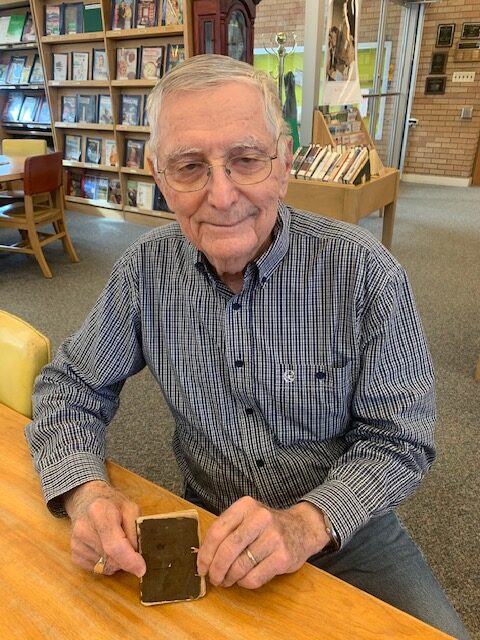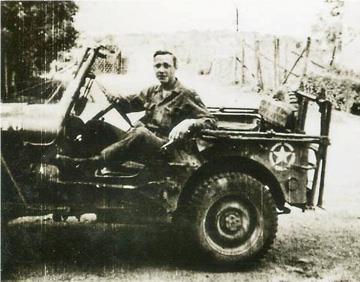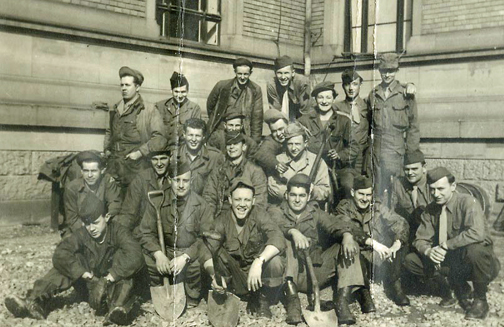One mission of the Kinsley Library is to preserve a record of the military service of our Edwards County veterans. Our archive contains records, files, and interviews that reflect their sacrifices. I decided to quite randomly select stories from our resources for America’s wars starting with Civil War through Desert Storm. The article turned out to be longer than I had anticipated, so here is Part I of the library’s tribute to our veterans.
Three of Darrel Miller’s great grandfathers served in the Civil War. They were all from Illinois. On his mother’s side, is William West Shannon who was in K Company of the 78th Illinois Infantry. He is buried in Trotter Cemetery. On his father side is William Miller, enlisted as a private in Company C, Sixty-Second Illinois Volunteer Infantry on April 28, 1864. He fought around Pine Bluff, Arkansas. His grandmother’s father, Japheth Flood, was a cooper by occupation. He joined Co C, 155th Regiment, Illinois Infantry on Feb. 16, 1865. It is said that he was a prisoner of war at Andersonville camp in Georgia. That camp was overcrowded to four times its capacity, with an inadequate water supply, inadequate food and unsanitary conditions. Of the approximately 45,000 Union prisoners held there during the last 14 months of the war, nearly 13,000 died, usually caused by scurvy, diarrhea and dysentery. He survived the camp but died two months later from chronic diarrhea.

The first time the horrors of the Spanish American War were felt in Kinsley was when the body of William Carroll was brought back on the train to Dodge City where “One could hardly think of the glory of conquest, standing by the door of the open express car, piled full of boxes containing the remains of men whose lives had gone out in a foreign land, while the fathers of one of these boys stood there bare-headed, tears in his eyes, waiting to receive the box of all that was left of his first-born….” (Kinsley Graphic, February 13, 1900)
William’s comrade wrote the following to his parents. “We moved out of our old trenches before Malabon and took a position four miles to the right, joining the flying column under Gen. McArthur in the advance on Malolas, the capitol of the Filipino government. We started at day-break on the morning of the 25th (1899) and reached Malolas after five days of hard fighting, the fighting that has brought sorrow to many an anxious heart in the states. It was in this advance that your son Willie fell fighting as bravely and gallantly as any man on the field that day.” (Graphic, May 12, 1899)
According to his captain, “William was at my side, not ten feet from me, when he was killed. He was killed instantly, the ball passing through his head. Your son was as good a soldier as I had in my company, always doing his duty.” (Graphic, July 28, 1899).
After the WWI armistice was signed on November 11, 1918, Tom Donnell, who was with the 20th Regiment Engineers, wrote home from France. “I take great pleasure in writing you this grand and great news of this great world war being at a final end…. I am so proud and so glad that I was one of the 2,000,000 American soldier boys who came across the Atlantic in great danger in crossing and came to France to help her and the rest of the Allies out and win or help win this great war. I feel in my heart that I have done my bit or part; at least I always tried to do it, at any rate….I was talking to a French soldier and also to an Italian soldier who were both right from the front, with four years’ service. They told me that we American soldiers have the world beat. We are looked upon today by all nations as the greatest soldiers in the world, and I believe we are at that.” (Graphic, December 26, 1918)
During World War II, Robert Stach (1925-1911) was only 18 when he found himself fighting in the mountains of France. He was part of the 100th Infantry Division and fought in Europe, at Ardennes, and the Battle of the Bulge. He first was in an antitank platoon and had set up a 105 mm gun at an intersection and had dug a foxhole and covered it with some kind of timber for protection from gun bursts coming down. During an interview in 2009 he told this story.

“I was on guard one night up there, and we were on the reverse side of a hill; the Germans were over there in the village, and we could hear them. You could hear their mess kits rattling; you could hear the wagon wheels on those cobblestone streets…. when it was about chow time, you could even hear their lunch, you know, their utensils rattling as they were going through the line. I was sitting right up there and all of our vehicles were stuck back in some trees, hidden out of the road, and this antitank gun was kind of in the open. There were two of us on guard at a time on that antitank gun, and we were supposed to be there when a tank come around the corner and had a square-on shot at it. I could hear the Germans on the other side of the hill; this was all right, but it was you know, after all, I had some of my own blood over there, too, in this place … I was sitting out there by myself in that pit that we had dug…, and then I heard a sneeze…I was so damned scared silly, so scared up there I didn’t know what to do, and then the sneeze…. then occasionally there was a little flash of lightning. I know, that it’s a wonder I’ve got a neck left yet, because every time it lightninged, I tried to make a 360 with my head to see where the sneezing was coming from, and I finally found it. Do you know that sheep sneeze, like you wouldn’t believe?”

These stories and many more are all from the library archive and most are accessible on line. I would like to challenge everyone to find time to share the stories of your ancestor/relative veterans with your family, your children, and the library archive. If you don’t know their stories, the library staff will help you find resources to discover them. This is a way to create a lasting memorial that remembers and honors veterans this year. (To be continued next week.)
